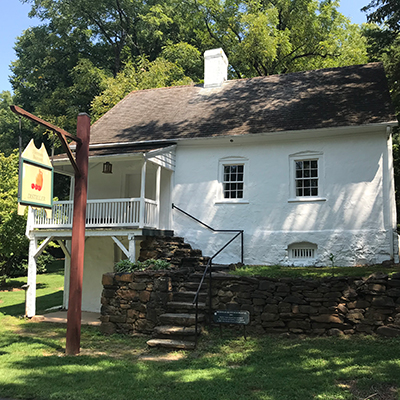The Brewer’s House
1754 Reconstructed Village | The Palisade | The Log House | The Brewer’s House | The Potter’s House | The Gemeinhaus
 “Our meals shall now be as follows: in the morning porridge, according to the weather…[and] brandy; at noon…barley-coffee, or sometimes brandy, or if the work is very hard a little beer…”
“Our meals shall now be as follows: in the morning porridge, according to the weather…[and] brandy; at noon…barley-coffee, or sometimes brandy, or if the work is very hard a little beer…”
— Bethabara Diary, January 9, 1758
Beer, brandy, and whiskey were produced in large quantities at Bethabara. According to monthly inventories in 1764, they kept an average of 270 gallons of brandy, 40 gallons of rye whiskey, and 90 gallons of beer on hand. The Moravians drank beer for refreshment and for its calories while working long, laborious days. Non-Moravians consumed whiskey in the tavern and purchased it from the store and distillery. Both Moravians and non-Moravians consumed brandy, made from peaches, blackberries, and apples, and believed that it had healing properties, especially when distilled with medicinal herbs and roots.
Built in 1803, the Brewer’s House is the earliest known brewer’s/distiller’s house in the United States. Bethabara is the site of the earliest known commercial brewery/distillery in North Carolina. The original log brewery and distillery, built in 1756, was located across from the Gemeinhaus. After two decades of large-scale production, a new brewery and distillery was built on the site of the Brewer’s House in 1777. The new brick and stone building caught fire and was destroyed on December 2, 1802, but was rebuilt on the original foundation using surviving construction materials. Completed in 1803, the Brewer’s House still stands today. The house served as both the living quarters for the family of the brewer/distiller and as a distribution point for the product (along with the Bethabara Tavern.) The new distillery was detached from the residence, but located nearby.
Bethabara’s Brewers and Distillers
Heinrich Feldhausen (1756-1762) assumed the role as the community’s distiller and brewer when the log brewery/distillery was constructed in December 1756. He remained in that role until he was expelled from Wachovia and sent back to Bethlehem on June 17, 1762. The passage from the Bethabara Diary reads, “Feldhausen left today with many tears. He had put our brewery and distillery into the best of order, but yielded to carnal desires and fell into all kinds of sin and shame.” Although the Moravians relied heavily on alcohol for economic success, they were vigilant about its “immoral” effects on members of their congregation.
Christian Pfeiffer (1760s-1772) took over the brewery and Niels Petersen took over the distillery after Feldhausen was expelled from the community. Pfeiffer arrived in Bethabara on October 11, 1755 and served the Church for several years before becoming Bethabara’s brewer in 1766. Peter Mücke worked for both men.
Peter Mücke (1772-1780s) served as Bethabara’s brewer/distiller for several years, even though the majority of the trades had been moved to Salem by 1774. He started in 1772, after the death of Pfeiffer. Peter, his wife Magdalena, and an enslaved woman lived in the Distiller’s house until the mid-1780s.
Phillip Vogler (1791), who had been filling in as Bethabara’s distiller, moved into the Distiller’s House with his family on November 1st, 1791. When he arrived, they installed wooden pipes for plumbing.
Herrman Buttner (1802) his wife Elisabeth, and their three children moved into the Distiller’s House from Friedland on June 1, 1802 to continue brewing and distilling.
Johann Christian Fockel (1807), his wife, and their two children moved to the house from Salem on July 28, 1807. Fockel took over the tanyard and distillery for the Buttner family, and remained there until moving back to Salem in 1814. From that time until the mid-1930s, the house probably served as a private residence.
From 1938 to 1953, the Brewer’s House was the parsonage for Bethabara Moravian Church. It served as the Administrative Office and Visitor Center of Historic Bethabara Park from 1970 until 1987, when the current Visitor Center was built. The Brewer’s House became a museum craft shop, storage location and, sporadically, housing for archaeologists—until restoration in 2002 brought it to its current state. Now, the 1803 Brewer’s House is used for special events and meetings of various community groups.
